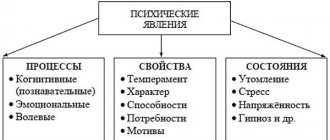At the moment, the concept refers to general methodological categories. It is currently in demand in many areas of human activity. It is also necessary to take into account the psychological state at a professional level when training representatives of many specialties. Including astronauts, athletes, law enforcement officers, specialists in the field of labor and teaching activities. It underlies the formation of universal human norms and rules of behavior. This category has been closely studied since the mid-twentieth century. The initial reason for its study was the formation of accounting in the formation of labor standards. This concept currently defines the uniqueness of the specific activity of a particular individual.
Components of health level
The general functional state of the human body consists of certain changes. They occur in all its physiological systems, namely in:
- central nervous; — motor; - endocrine; - respiratory; - cardiovascular, etc.
In addition, the functional state of a person is significantly influenced by changes that are possible during the course of mental processes, such as sensation and perception, thinking and memory, attention and imagination. Your health also depends on subjective experiences.
Cognitive content
According to this classification, feelings are divided into simple and complex. The first ones are fast and bright (anger, joy). They occur momentarily, immediately upon encountering a factor that motivates them (for example, when a guy invites a girl on a date, she rejoices). The second ones are longer and often contradictory (after receiving an invitation, she begins to analyze the situation and doubt).
Classification of human conditions
There are a huge number of factors influencing human behavior and health. That is why the functional state of the body in each specific situation is unique. Nevertheless, from a huge number of special cases, scientists have identified the most basic ones. They are grouped into certain classes. This state:
- normal life activity; - pathological; - borderline.
It is possible to assign a functional state to one class or another only if certain evaluation criteria are used, namely, reliability and cost of activity. The first of them characterizes a person’s ability to work with a given level of accuracy, reliability and timeliness. The indicator of the cost of activity serves to characterize the functional state from the point of view of depletion of the vital forces of the body, which ultimately has a direct impact on the level of its health.
Based on these criteria, the functional state is differentiated into acceptable and unacceptable. This classification is used in studies of the possibility of working.
Which class the patient’s functional state belongs to is decided by doctors specifically depending on a particular case. For example, a state of fatigue. It leads to a decrease in performance indicators, but it is incorrect to consider it unacceptable. However, if the degree of fatigue exceeds the lower limits of a certain norm, then in this case the functional state is prohibited. This assessment is not given by chance.
Excessive strain on a person’s psychological and physical resources worsens his physical condition. In the future, this kind of fatigue is a potential source of various ailments. On this basis, normal and pathological functional health states are distinguished. The last of these two classes is the subject of medical research. For example, after prolonged experiences or stress, diseases of the blood vessels and heart, the digestive system, as well as neuroses often occur.
There is another classification of human functional states. It is built using criteria for the adequacy of responses to the requirements of work activity. According to this classification, functional states are related to adequate mobilization and dynamic mismatch.
The first of these two types is characterized by a correspondence between the degree of intensity of a person’s capabilities and the requirements that are placed on him in specific conditions. This condition can be disrupted by increased stress, duration and excessive activity. In this case, fatigue accumulates in the body and a condition related to dynamic mismatch arises. In this case, in order to achieve the desired result, a person will be forced to make efforts that exceed what is necessary.
Primary examination by a doctor
When contacting medical institutions, a specialist assesses the patient’s functional state based on examination, survey, laboratory and other studies. Sometimes similar events are carried out in relation to patients who are undergoing surgery. In this case, comprehensive studies are carried out to identify the level of a person’s functional state.
At the same time, the patient’s complaints and his anatomical data are considered, and the results of a clinical examination are evaluated, containing information about:
- blood pressure; - heart rate; — decrease or increase in body weight; - presence of edema, etc.
Condition of the vascular system and heart
Where does the study of the functional state of the body begin? From an assessment of the functioning of his heart and blood vessels. And this is not surprising. The normal functional state of the cardiovascular system allows the delivery of oxygen to every cell of the human body. This allows the whole body to work as usual. In addition, assessment of the condition of blood vessels and the heart is in the first place due to the fact that in modern man they are extremely vulnerable.
What are the main indicators of the functional state of such an important system for us? This is the pulse, indicating the heart rate, as well as analyzing its changes.
This indicator for men at rest should be from 55 to 70 beats per minute, and for women - from 60 to 75. At higher values, the pulse is considered rapid, which is a sign of tachycardia. A heart rate below normal indicates a disease such as bradycardia.
Also, your health directly depends on your blood pressure. Its normal value is in the range of 100-129/60-79 mm. Hg Art. High blood pressure indicates hypertension, and low blood pressure indicates hypotension.
It is impossible to assess the functional state of the cardiovascular system without studying the characteristics of changes in its functioning after intense physical activity. The duration of the body’s recovery is also taken into account. Similar studies are carried out using a variety of functional tests.
How to learn to recognize negative emotions in yourself and others
Emotional intelligence is a course from the brain development platform Vikium. It consists of 20 lessons and is designed to improve identification, understanding, management of your emotions, as well as to recognize the emotions of others.
The author of the course is Oleg Kalinichev. He is the director of Paul Ekman International in Russia.
Paul Ekman is a world expert in the psychology of emotions, deception detection and nonverbal behavior:
- included in the top 100 most influential people in the world;
- intelligence consultant for the CIA, FBI, Scotland Yard;
- the world's best “LIVING LIE DETECTOR” Forbes;
- 50 years of scientific research;
- author of 170 scientific papers and 15 books;
- scientific consultant for the TV series “Lie to Me” and “Inside Out”.
What you can learn by taking this course:
- recognize deceitful people you meet at work and in your personal life;
- see the manifestation of empathy and other hidden emotions;
- the ability to “read” the interlocutor;
- determine where the information leak occurred;
- the ability not to show off your emotions;
- the ability to see the manipulator;
- improve relationships in your personal life;
- become confident.
The cost of training is 990 rubles. Registration is made automatically on the website.
Within 7 days you can get your money back if you are not satisfied with the course.
You can already find out how developed your EQ is. To do this, take an online emotional intelligence test.
There is also an article on levelself.ru that contains the best courses on EI.
Check out 14 EQ courses
Respiratory system condition
To ensure the vital functions of the body, a constant process of oxygen intake and removal of water vapor and carbon dioxide is necessary. The respiratory organs are responsible for this.
Three parameters are included in assessing the indicators of the functional state of this system. These are the depth, frequency and type of breathing.
One of the most important indicators is the respiratory rate. This is the breathing rate that is necessary for the normal supply of oxygen to all body systems. The values of this indicator depend on a number of reasons. This may be body or environmental temperature, as well as the period before or after eating. The breathing rate varies depending on the position of the body. Its smaller values are observed in a lying position, and its larger values are observed in a standing position. Men breathe 2-4 breaths per minute less frequently than women. On average, the normal RR value ranges from 14 to 16.
How to determine the functional state of the respiratory system? This is possible by analyzing:
1. The ratio of heart rate and respiratory rate. At rest and during physical activity, these values range from 4:1 to 5:1. An increase in these indicators due to heart rate will indicate a decrease in the thermodynamics of the heart. A decrease in values due to an increase in RR will indicate less economical lung function.
2. Holding your breath. To do this, a Stange test is performed. If a person was able to hold his breath for more than 80 seconds, we can talk about the excellent condition of his lungs, 70-80 - good, 65-70 - average, less than 65 - weak.
How to create a good mood
When sad thoughts overwhelm you, you need to take action - create positive emotions. What to do to improve your mood:
- Control your emotions. Don’t pay attention to minor troubles, don’t get annoyed because of caustic remarks addressed to you and insults caused to you. To avoid such provoking factors, it is better to limit communication with people who try to offend on occasion. If the offense was caused by loved ones, it is better to forgive and forget. By forgiving, you get rid of the feelings of anger and anger that destroy your nervous system in the first place.
- Look at life circumstances and external conditions with humor. By perceiving the world through the prism of humor, you will be able to maintain a good mood regardless of the vicissitudes of fate. A black streak is always replaced by a white streak - you need to believe in the best and wait for a bright moment in your life.
- Don't dwell on problems. If negative emotions come flooding in, you shouldn’t stay at home and revel in your “grief.” Physical activity - walking in the fresh air, playing sports - will set your thoughts in a positive mood. Swimming is the best option for people who tend to indulge in sadness. Light splashes and sounds of flowing water are soothing. If you add physical activity to the psychological impact, followed by acceleration of blood flow and metabolism, it becomes clear why sad thoughts disappear without leaving a trace. An alternative option for spending time is a company of cheerful and loyal friends, where there is never a dull moment.
- Change the life. Start small and global positive changes will not keep you waiting. The principle of operation is a “snowball”, which initially is a small lump, but constantly moving, it increases layers and volumes. To begin with, you can update your wardrobe, hairstyle, and accessories. Or find a new hobby - nothing distracts you from sad thoughts like an interesting, exciting activity. People who have a favorite hobby have no time to be sad.
- Know how to relax. Simple and accessible means will help in this matter - aromatherapy, a warm bath with a thick head of pleasantly smelling foam, favorite musical compositions that cause a relaxation effect. A delicious cake (ice cream) in a single copy will not affect your waist size, but will provide a lot of pleasant impressions.
To calm down, sometimes it’s enough to look at your life from the outside, to figure out what the causes of anxiety and nervous tension are. Thinking about your goals, plans, and relationships with people will help you dot the i’s. It’s better to focus on the current moment and finish the job you started than to rush around in search of new horizons and unconquered peaks. The rationality and necessity of actions is assessed against the background of promising results.
You need to understand whether you really want to become a deputy director (a holder of an honorary status, rank or title, the owner of a new car, gadget, jewelry) in order to devote all your free time to achieving your goal, exhausting your strength and shaking your nervous system. Consistency, prudence, and common sense will help you distinguish between main and secondary tasks, set life priorities and find peace of mind.
Mood varies, depends on influencing factors, and in most cases can be corrected using simple methods.
Condition of the central nervous system
The performance of all organs is assessed during the examination and based on the results of a whole range of biochemical tests. However, as for the nervous system, here specialists face a number of difficulties associated with the limitations of instrumental research.
A person’s physical condition directly depends on the performance of his central nervous system. Moreover, the strength of the nervous processes occurring in our body is quite great. This can be evidenced by the fact that our emotional sphere also depends on the functioning of the nervous system. These are stability of mood and the ability to restrain yourself, perseverance and courage, as well as many other criteria.
In order to determine the functional state of the central nervous system, it is important for a specialist to find out the patient’s sleep characteristics. The fact is that night rest has two phases. This is slow and fast sleep. During the night, these phases change places, repeating from 3 to 5 times. If this alternation is disrupted, a sleep disorder is diagnosed, which indicates mental and neurotic disorders in the body.
An important indicator of the functional state of the central nervous system is coordination of movements. To determine this indicator, special samples are used. With their help, the static and dynamic coordination of the patient’s movements is revealed.
A disorder of this function indicates overwork of the body or the presence of pathological changes that have arisen in certain areas of the nervous system.
Also, to clarify the functional state of the central nervous system, the following are used:
— EEG, or electroencephalogram, which records the electrical activity of brain tissue; - REG, or rheoencephalogram, examining the cerebral blood flow of the brain vessels; - EMG, or electromyography, which records the electrical activity of skeletal muscles; — chronaximetry, which studies the excitability of nervous tissue depending on the period of action of the stimulus; - Romberg test, which detects imbalance when a person is in a standing position; - Yarotsky test, which determines the sensitivity threshold of the vestibular analyzer; — finger-nose test, for which the patient must reach the tip of the nose with his index finger (failure to reach the tip may indicate neurosis, brain injury, fatigue and other functional impairments).
Studies of the nervous system can reveal some of its pathologies. These are neuroses or neurosis-like conditions, neurasthenia, etc.
Response scale
This technique is a questionnaire of 25 statements that determines the degree of development of empathy in an individual.
The person taking the test needs to rate his/her agreement: always, often, rarely, never.
| № | Judgment | Answer | |||
| IN | H | R | N | ||
| 1 | I feel sad when I see someone feeling lonely in company. | ||||
| 2 | When those around you cannot restrain themselves and openly show their emotions, it is unpleasant. | ||||
| 3 | When a person gets excited next to me, I feel the same. | ||||
| 4 | I believe that tears of happiness are stupid. | ||||
| 5 | I also experience the troubles of my friends. | ||||
| 6 | Sometimes love songs make me sensitive. | ||||
| 7 | I would be very worried if I had to convey bad news to anyone. | ||||
| 8 | My condition is greatly influenced by my environment. | ||||
| 9 | I would like to have a job that involves communication. | ||||
| 10 | I love seeing people receive gifts. | ||||
| 11 | When I see/hear that a person is crying, I get upset myself. | ||||
| 12 | Listening to certain music makes me feel happy. | ||||
| 13 | When I read a work of fiction, I worry so much, as if all this is happening in reality. | ||||
| 14 | I get angry when I see a person being treated horribly. | ||||
| 15 | I can remain calm even when everyone around me is panicking. | ||||
| 16 | It makes me nervous when people shed tears. | ||||
| 17 | When I make a decision, no one else's opinion usually matters. | ||||
| 18 | I also get angry when people around me are worried about something. | ||||
| 19 | I get worried if I see people worrying about trifles. | ||||
| 20 | I get worried when I see animals suffering. | ||||
| 21 | It's stupid to worry about what happens in a book or movie. | ||||
| 22 | I feel sad when I see weak people. | ||||
| 23 | I get very emotional when watching a film. | ||||
| 24 | I can be indifferent to any disturbance going on around me. | ||||
| 25 | Children cry for no serious reason. | ||||
Ask a question
Results
| № | Number of points per answer | |||
| B – I agree (always) | H - often | R - rarely | N - never | |
| 1 | 4 | 3 | 2 | 1 |
| 2 | 1 | 2 | 3 | 4 |
| 3 | 4 | 3 | 2 | 1 |
| 4 | 1 | 2 | 3 | 4 |
| 5 | 4 | 3 | 2 | 1 |
| 6 | 4 | 3 | 2 | 1 |
| 7 | 4 | 3 | 2 | 1 |
| 8 | 4 | 3 | 2 | 1 |
| 9 | 4 | 3 | 2 | 1 |
| 10 | 4 | 3 | 2 | 1 |
| 11 | 4 | 3 | 2 | 1 |
| 12 | 4 | 3 | 2 | 1 |
| 13 | 4 | 3 | 2 | 1 |
| 14 | 4 | 3 | 2 | 1 |
| 15 | 1 | 2 | 3 | 4 |
| 16 | 1 | 2 | 3 | 4 |
| 17 | 1 | 2 | 3 | 4 |
| 18 | 4 | 3 | 2 | 1 |
| 19 | 4 | 3 | 2 | 1 |
| 20 | 4 | 3 | 2 | 1 |
| 21 | 1 | 2 | 3 | 4 |
| 22 | 4 | 3 | 2 | 1 |
| 23 | 4 | 3 | 2 | 1 |
| 24 | 1 | 2 | 3 | 4 |
| 25 | 1 | 2 | 3 | 4 |
| Sum | ||||
Now calculate the results:
- 11 points - extremely reduced level of empathy;
- 12-36 - low;
- 37-62 - normal;
- 63-81 - high;
- 82-90 - elevated.
Fatigue
The functional mental state of the body, as a rule, examines the dynamics of a person’s performance. In this case, one of the main indicators is the body’s fatigue, that is, its natural reaction that occurs when tension increases during prolonged work.
From a physiological point of view, the fatigue that occurs in a person indicates the depletion of his internal reserves. At the same time, all body systems transfer their functional activity to other modes. For example, due to an increase in the number of heart contractions, the minute volume of blood flow decreases. This process, like many others, slows down the pace of work, disrupts the accuracy, coordination and rhythm of movements.
As fatigue increases, the emotional sphere also suffers. Changes affecting mental processes slow down the functioning of the senses, transferring them to an inertial mode. Also, when tired, the reaction rate decreases, which indicates an increase in the sensorimotor reaction time.
It becomes difficult for a tired person to perform complex movements. In addition, in this state there is a narrowing of the scope of attention with a decrease in the functions of its distribution and switching. As a result, the conscious control that a person must exercise over the performance of his activities is significantly deteriorated. The deterioration of the functional state of the body during fatigue leads to difficulty in retrieving information contained in long-term memory. The short-term storage system is also disrupted.
As fatigue increases, a person’s motives for activity are transformed. Thus, in the early stages of the work process, a businesslike mood takes place. However, due to the accumulation of fatigue, motives for avoiding activities become predominant.
Emotional reactions
- Lability is the variability of the manifestation of experiences. They always fluctuate over a fairly wide range (from light sentimentality to hysteria).
- Monotony is monotony, static or no sensory responses to what is happening.
- Responsiveness and empathy - the ability to quickly and flexibly respond to external influences, the ability to put oneself in the place of another, to empathize.
- Viscosity – focusing on a long-term feeling (for example, instead of reacting to the situation, a person returns to old grievances, failures).
- Coarsening is the inability to realize the appropriateness and admissibility of expressing emotions, loss of restraint and delicacy.
- Alexithymia is difficulty in identifying one’s feelings and their expression, the inability to distinguish experiences from physical sensations.
- Rigidity – immobility and limited range of response.
Sometimes a person’s behavior is demonstrative in nature, which is associated with his social functions. That is, people portray a certain involvement and emotionality in a situation that requires it. In this case, they speak of the existence of an emotional action, and not a reaction.
Performance stages
During the work process, the human body goes through four stages. They include the stages:
— working in; — optimal performance; — fatigue; - the final impulse.
After completion of the last stage, a mismatch of work activity occurs. How to restore optimal performance? To do this, you need to stop activities in order to actively or passively rest.
Sometimes a person experiences cumulation, or accumulation of fatigue. This happens in cases where the fullness or duration of rest periods is insufficient for him. In such cases, chronic fatigue occurs, which is expressed in a feeling of constant fatigue, drowsiness, etc. Objective signs of this functional state in its initial stages are little expressed. But their appearance can always be indicated by a change in the ratio of periods such as the run-in stage, as well as optimal performance.
Functions
Psychologists identify a number of functions that emotions perform:
- Mobilization. This function manifests itself at the physiological level. The main manifestations are the release of adrenaline into the blood, dulling of sensations, narrowing of consciousness. The described manifestations help to discard unnecessary thoughts and act according to a specific situation.
- Grade. With the help of emotions, you can instantly assess the current situation or external stimulus. The emotional assessment appears before a detailed answer is composed. The first impression of a new person is extremely difficult to destroy.
- Compensation. Emotions can be called the highest order of intelligence. They do not go against reason. Psychologists call them a resource for solving various problems. For example, with the help of positive emotions you can strengthen needs, and with the help of negative ones you can reduce their effectiveness.
- Trace formation. Situations often happen when emotions appear too late, when everything is over, nothing serious can be changed. The created emotional effect is fixed in memory and will arise when similar situations arise.
- Communication. Emotions have an expressive component. They are transparent to society. For example, when one person expresses pain, the bitterness of loss, those around them have an altruistic motivation, a desire to help. Often such manifestations lead to new acquaintances, which can play a significant role in life.
Tension
This is one of the indicators of the functional state of a working person’s body. The degree of intensity of activity can be determined based on the structure of the labor process. This takes into account the content of the workload, as well as its saturation and intensity.
There are two classes of states of tension. The first of them is specific. It determines the intensity and dynamics of psychophysical processes that underlie the performance of labor skills. The second class of tension is nonspecific. It reveals the psychophysical resources of the employee.
Maintaining the normal functional state of the body
The limit of a person’s performance depends on his:
— health; — age; - nutrition; — the magnitude of the body’s reserve capabilities; — motivation; — experience and professional preparedness; — sanitary and hygienic working conditions; - personality orientation.
In order to maintain a normal level of functional state of the body, it is necessary to comply with conditions that prevent fatigue. To do this, it is important to correctly alternate between work and rest.
However, not all problems associated with fatigue can be solved by taking breaks from work. An important role in this case will be the organization of the place of personnel and their work. In this case, the following conditions must be met:
— ensuring sufficient work space; — availability of artificial and natural lighting; — permissible level of vibration, noise and other production factors; — presence of warning signs and necessary instructions; — cost-effectiveness and trouble-free maintenance of working equipment, etc.
Main types
In psychology, the main types of human mood include negative, positive and neutral. The level of each component varies significantly, which determines the emotional background. Neutral mood is a state of abstraction or expectation, which is characterized by muted emotions and lack of emotionality.
This state is characteristic of introverts - people who turn inward, focused on their own personality as opposed to focusing on the outside world. There are different classifications of human mood types. Some research scientists identify common options - working, happy, sad, neutral, irritable.
American psychologist R. Thayer describes 4 types of mood, taking into account the level of tension energy. This is calm-energetic, calm-tired, tense-energetic, tense-tired. The doctor claims that it is possible to positively influence mood with the help of sufficient sleep, proper nutrition, dosed, regular physical activity, drawing parallels between the emotional background and a healthy lifestyle.
They distinguish the type of mood provoked by an object of art, a work of musical or literary genre - a poem, a painting, a melody. For example, looking at a painting with a lot of detail and certain color combinations can create a peaceful, calm mood. Colors that reduce fatigue and promote immersion in a state of mental balance include blue, white, light gray, cream, yellow, green, orange.










